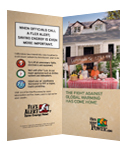Water Heater Tips
No Cost
- Like dishwashers, up to 90% of the cost of operating washing machines is associated with the energy needed to heat the water. Reduce the amount of hot water used by washing clothes in cold water, instead of hot or warm water. You can save up to 10% on water heating costs by washing and rinsing your clothes in cold water. Select a laundry detergent formulated to clean effectively in cold water. Washing only full loads will also reduce hot-water consumption.
- Reduce the amount of hot water used by turning the hot-water faucet off while shaving or brushing your teeth.
- Use off-peak power to heat water.
For those who have an electric water heater, this usage contributes to the electric utility company's "peak load," or the largest amount of power demand that they have to meet on a daily basis.
Some utilities are required to offer their customers "time of use" rates that vary according to the demand on their system. Lower rates may be charged at "off-peak" times and higher rates at "on-peak" times.
Check with your local electric utility to find out if it offers time-of-use rates for residential customers. Some utilities even offer incentives for customers who allow their utility to install control devices that shut off electric water heaters during peak demand periods.
- When you plan to be away from home for three or more days, turn the water heater thermostat down to the lowest setting, or turn the heater off completely. Be sure you know how to relight the pilot light on the gas heater before you turn it off.
Low Cost
- For electric water heaters, install a timer that can automatically turn the heater off at night and on in the morning. A simple timer can pay for itself in energy saved in about one year. More expensive, multisetting timers are also available.
Timers for gas water heaters are not as useful or cost effective as those designed for electric water heaters. This is because the pilot light supplies some heat during the night, offsetting some of the energy savings achieved by using the timer.
Add "heat traps" to the water heater, if not already installed. Heat traps, also called one-way valves, allow water to flow into the tank and prevent unwanted hot-water flow out of the tank. Heat traps may require professional installation, which could be expensive. But if it is installed at the same time as a new water heater, heat traps are much more cost effective. Most new water heaters have factory installed traps, saving you the time and expense of installing one yourself.
- Insulate the first 6 feet of the hot and cold water pipes connected to the water heater.
- Insulate your hot-water storage tank, but be careful not to cover the thermostat. For natural gas or oil heaters, also be careful not to cover the heater's top, bottom, or burner compartment. Follow the manufacturer's recommendations; when in doubt, get professional help.
- Reduce the amount of hot water used by installing low-flow showerheads and faucet aerators.
Older showerheads deliver four to five gallons of water per minute. A new, two-and-a-half-gallon-per-minute showerhead will reduce your water consumption by one-third to one-half. A typical bathtub holds about 60 gallons. A top-quality, low-flow showerhead will cost $10 to $20 and pay for itself in energy saved within four months.
For bathroom faucets, aerators that deliver 0.5 to 1 gallon of water per minute may be sufficient. Kitchen faucets may require a higher flow rate of 2 to 4 gallons per minute if you regularly fill the sink for washing dishes. On the other hand, if you tend to let the water run when washing dishes, the lower flow rate of 0.5 to 1 gallon per minute may be more appropriate. Some aerators come with shut-off valves that allow you to stop the flow of water without affecting the temperature.










